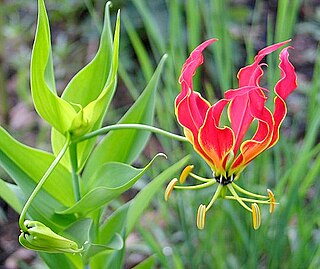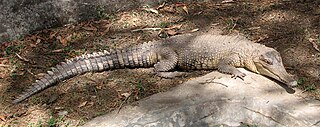
Kiwifruit or Chinese gooseberry is the edible berry of several species of woody vines in the genus Actinidia. The most common cultivar group of kiwifruit is oval, about the size of a large hen's egg: 5–8 centimetres in length and 4.5–5.5 cm in diameter. It has a thin, fuzzy, fibrous, tart but edible light brown skin and light green or golden flesh with rows of tiny, black, edible seeds. The fruit has a soft texture with a sweet and unique flavour.

A vine is any plant with a growth habit of trailing or scandent stems, lianas, or runners. The word vine can also refer to such stems or runners themselves, for instance, when used in wicker work.

Phaseolus coccineus, known as runner bean, scarlet runner bean, or multiflora bean, is a plant in the legume family, Fabaceae. Another common name is butter bean, which, however, can also refer to the lima bean, a different species.

Mucuna is a genus of around 114 accepted species of climbing lianas (vines) and shrubs of the family Fabaceae: tribe Phaseoleae, typically found in tropical and subtropical forests in the Americas, sub-Saharan Africa, southern, southeastern, and eastern Asia, New Guinea, Australia, and the Pacific Islands.

The otter civet is a semiaquatic viverrid native to Thailand, Malaysia, Indonesia and Brunei. It is believed to be undergoing severe population decline due to habitat destruction and is classified as an endangered species by the IUCN Red List.

Strongylodon macrobotrys, commonly known as jade vine, emerald vine or turquoise jade vine, is a leguminous vine endemic to the Philippines. It is a popular ornamental plant known for its cascading clusters of vibrant turquoise or greenish-blue claw-shaped flowers. Cultivating jade vine requires a tropical environment, making it a popular choice in botanical gardens and conservatories. The plant's striking appearance and limited distribution contribute to its allure among plant enthusiasts worldwide.

Coccinia grandis, the ivy gourd, also known as scarlet gourd, dhendura and kudri, is a tropical vine. It grows primarily in tropical climates and is commonly found in the Indian states where it forms a part of the local cuisine. Coccinia grandis is cooked as a vegetable dish.

Flindersia is a genus of 17 species of small to large trees in the family Rutaceae. They have simple or pinnate leaves, flowers arranged in panicles at or near the ends of branchlets and fruit that is a woody capsule containing winged seeds. They grow naturally in Australia, the Moluccas, New Guinea and New Caledonia.

Cordia sebestena is a shrubby tree in the borage family, Boraginaceae, native to the American tropics. It ranges from southern Florida in the United States and the Bahamas, southwards throughout Central America and the Greater Antilles. Common names have included siricote or kopté (Mayan) in 19th Century northern Yucatán, scarlet cordia in Jamaica, and Geiger tree in Florida.

Mucuna pruriens is a tropical legume native to Africa and tropical Asia and widely naturalized and cultivated. Its English common names include monkey tamarind, velvet bean, Bengal velvet bean, Florida velvet bean, Mauritius velvet bean, Yokohama velvet bean, cowage, cowitch, lacuna bean, and Lyon bean.

Eupomatia is a genus of three species of plants in the ancient family Eupomatiaceae, and is the sole genus in the family. Eupomatiaceae is recognised by most taxonomists and classified in the plant order Magnoliales. The three described species are shrubs or small trees, native to the rainforests and humid eucalypt forests of eastern Australia and New Guinea. The type species Eupomatia laurina was described in 1814 by Robert Brown.
Flame of the forest is a common name for several plants and may refer to:
Syconycteris is a genus of megabat in the family Pteropodidae. There are three described species at present, with more likely to be added. Members of this genus are found in Indonesia, New Guinea and Australia. Their diet mainly consists of nectar and fruit, making them important for pollination and seed dispersal in their environment.

Gloriosa superba is a species of flowering plant in the family Colchicaceae. Common names include flame lily, climbing lily, creeping lily, glory lily, gloriosa lily, tiger claw, the Poison Plant, agnishikha and fire lily.
Mucuna bracteata is a leguminous plant. It is a nitrogen-regulating plant that is used in agroecosystems operating around certain types of agricultural plant systems including: rubber trees, oil palm, citrus and coconut. M. bracteate is a cover crop which helps to cover and shield the soil from weeds or plants, as well as providing rapid growth for existing agricultural crops, preventing soil erosion, and providing nitrogen fixation. The Mucuna bracteata crop grows about 10–15 cm/day in conditions similar to those that rubber and palm oil plants thrive in.

The Central African slender-snouted crocodile is one of two species of crocodiles in the genus Mecistops. It was once thought to be a population of the West African slender-snouted crocodile but was elevated to a species after two detailed studies, one in 2014 and the other in 2018.

Mucuna gigantea, commonly known as burny bean, burney bean, velvet bean or sea bean is a species of liana from the legume family Fabaceae. Its natural range roughly follows the perimeter of the Indian Ocean and includes Africa, India, Malesia, New Guinea and northern Australia. Many parts of the plant - in particular the new growth, flowers and fruit - are covered in fine irritant hairs.

Mucuna urens is a species of large liana from the family Fabaceae. The plant is native to tropical Central and South America, and has been introduced into the Republic of the Congo. Common names include horse-eye bean and ox-eye bean.
Mucuna paniculata is a species of flowering, woody vine in the family Fabaceae, the bean family. It is native to northern Madagascar where it is locally known in Malagasy as vohinkovika. It flowers between June and August.
Purple jade vine can refer to:














